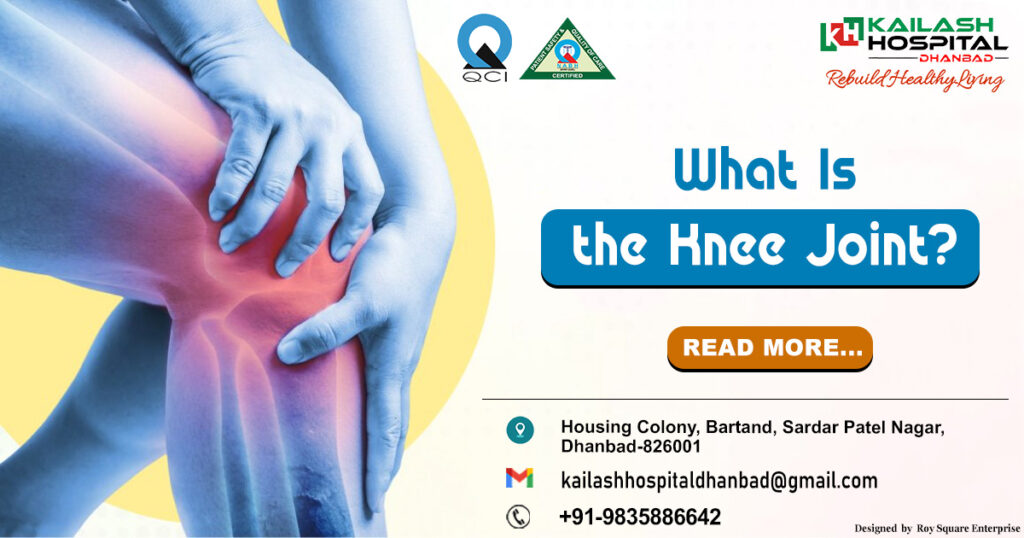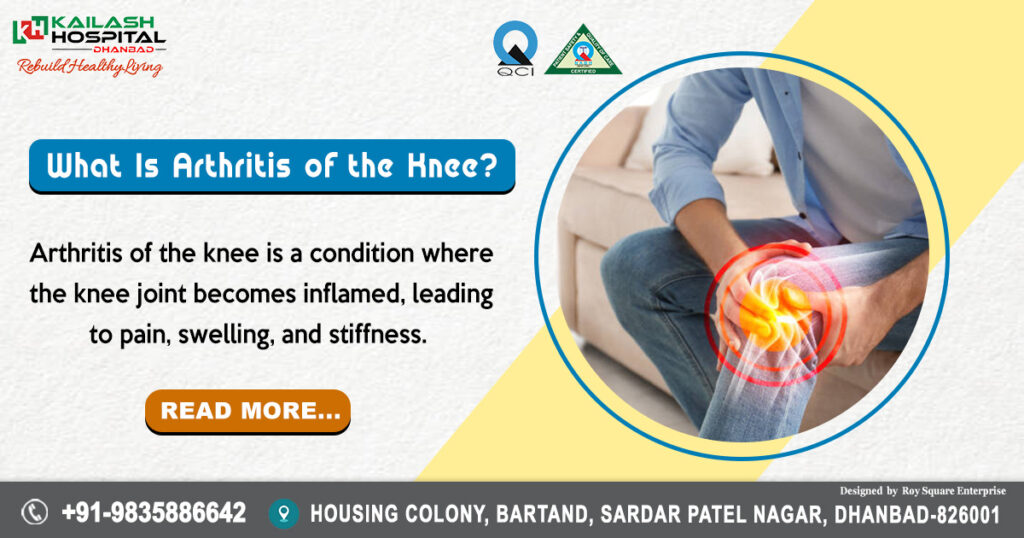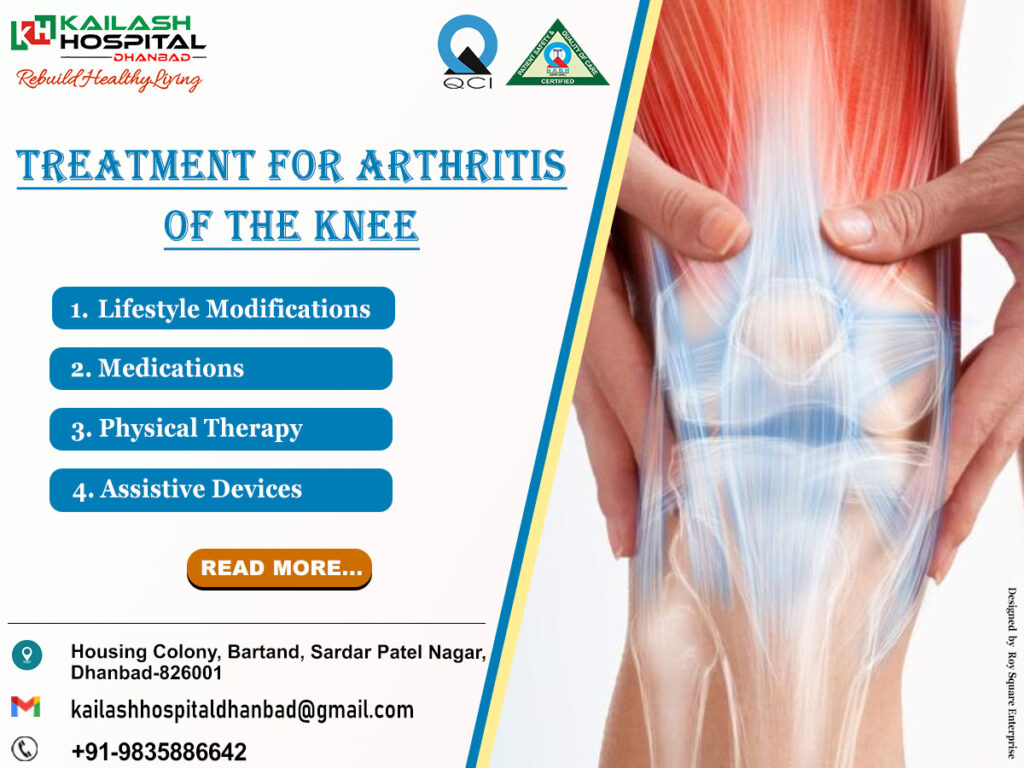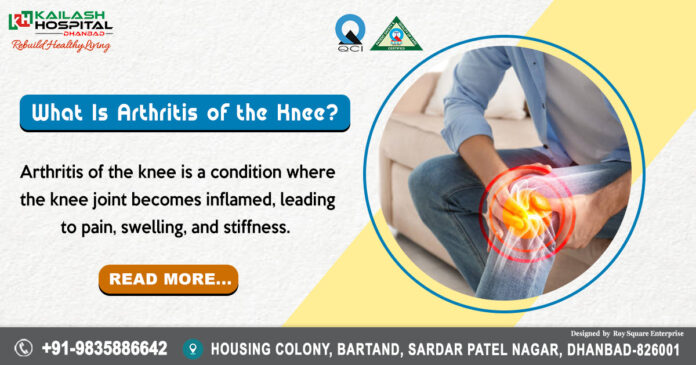Knee arthritis is one of the most common causes of pain, stiffness, and disability in adults—particularly as we age. When everyday movements like walking, bending, or climbing stairs become painful, life quality can suffer significantly. Thankfully, modern orthopedics offers many effective treatments to manage or reverse symptoms. At Kailash Hospital, Dhanbad, consultant orthopedic surgeon Dr. Ashish Bajaj brings world‑class expertise in diagnosing and treating knee arthritis. In this blog, we’ll explore why knee arthritis occurs, how to recognize its signs early, and what treatments—from lifestyle adjustments to advanced surgery—can help you take back your mobility and comfort.
Many types of arthritis affect the knee, including osteoarthritis (OA), rheuma- toid arthritis (RA), and post-traumatic arthritis. Osteoarthritis, often referred to as” wear-and-tear” arthritis, is the most common form and typically develops with age. Rheumatoid arthritis, on the other hand, is an autoimmune disorder where the body’s immune system attacks the joint lining. Post-traumatic arthritis occurs after an injury to the knee, such as a fracture or ligament tear.
What Is the Knee Joint?

Before diving into arthritis of the knee, it’s essential to understand what is the knee joint. The knee is a hinge joint that connects the thigh bone (femur) to the shin bone (tibia). It also includes the kneecap (patella) and the smaller fibula bone. The joint is supported by muscles, tendons, ligaments, and cartilage, which work together to provide stability and mobility.
Key Components of the Knee Joint :
- Articular Cartilage: A smooth, slippery tissue that covers the ends of bones, allowing them to glide effortlessly.
- Meniscus: Two C-shaped cartilage pads that cushion and absorb shock between the Femur bone and Tibia bone.
- Synovial Membrane: A thin lining that produces synovial fluid to lubricate the joint.
- Ligaments (ACL, PCL, MCL, LCL): Strong bands of tissue that stabilize the knee.
- Tendons: Link muscles to bones facilitating body movement.
When any of these structures are damaged—especially the cartilage—the knee joint becomes inflamed, leading to arthritis of the knee.
What Is Arthritis of the Knee ?

Arthritis of the knee is a condition where the knee joint becomes inflamed, leading to pain, swelling, and stiffness. It occurs when the cartilage that cushions the bones wears away, causing bone-on-bone friction. Over time, this can cause joint harm, limited movement, and ongoing pain.
Knee arthritis refers to inflammation and degeneration of the knee joint. There are several types:
- Osteoarthritis (OA): The most common form—often known as “wear‑and‑tear” arthritis—where cartilage thins over time, bone spurs form, and inflammation sets in. At Kailash Hospital, they emphasize that OA is a progressive disease but doesn’t have to take control of your life.
- Rheumatoid arthritis (RA): An autoimmune condition where the body attacks joint linings, causing pain, swelling, and eventual erosion.
- Post‑traumatic arthritis: Follows an injury such as a fracture or ligament tear, which alters knee biomechanics and leads to wear.
- Other types: Including gout, pseudogout, and post‑infectious arthritis.
Why It Happens
- Age and genetics: Aging increases cartilage breakdown; a family history can raise your risk.
- Excess weight: More load on knee joints accelerates wear.
- Joint injury or overuse: Past fractures, torn ligaments, or excessive repetitive activity can trigger damage.
- Biomechanical misalignment: Knock‑knees, bow-leggedness, or uneven gait patterns strain certain joint areas.
Types of Knee Arthritis
There are several distinct types of arthritis that can affect the knee. Understanding these types helps in choosing the right treatment plan.
1. Osteoarthritis (OA)
- Most common type
- Caused by gradual wear and tear of cartilage
- Usually affects people above 50
- Can affect one or both knees
🟢 Progressive in nature but manageable with proper care
2. Rheumatoid Arthritis (RA)
- Autoimmune disease: the body attacks its own joint lining (synovium)
- Affects both knees symmetrically
- Leads to swelling, joint erosion, and deformity
🟢 Often begins in middle age but can affect younger adults too
3. Post-Traumatic Arthritis
- Occurs after a knee injury—like fractures, ligament tears, or meniscus damage
- Joint instability or misalignment after trauma speeds up wear
🟢 May develop months or years after the injury
4. Gouty Arthritis
- Caused by uric acid crystal build-up in the joint
- Leads to sudden attacks of severe knee pain, swelling, and redness
🟢 Often associated with diet and kidney function
5. Psoriatic Arthritis
- Seen in people with psoriasis, an autoimmune skin disease
- May cause joint swelling and stiffness, sometimes before skin lesions
🟢 Can mimic other types but has distinct features like nail changes
6. Septic Arthritis
- Infection in the knee joint causing rapid inflammation, redness, and fever
- Requires emergency treatment
🟢 Often seen in people with compromised immunity
Symptoms of Knee Arthritis
Recognizing the symptoms of knee arthritis early can lead to better management and improved quality of life. The severity of symptoms varies depending on the type and stage of arthritis.
✅ Pain
- Worsens with activity and improves with rest
- In OA, pain is gradual; in RA or gout, it can be sudden and sharp
✅ Stiffness
- Common in the morning or after periods of inactivity
- May ease with light movement
✅ Swelling and Tenderness
- Due to inflammation or fluid build-up inside the joint
- Joint may feel warm to touch
✅ Reduced Range of Motion
- Difficulty fully bending or straightening the knee
✅ Crepitus (Grinding or Cracking Sounds)
- Felt or heard during movement due to rough joint surfaces
✅ Instability or Buckling
- Feeling that the knee may “give out” under body weight
✅ Deformity
- In advanced cases, visible misalignment (bow-legged or knock-kneed appearance)
Dr. Ashish Bajaj at Kailash Hospital, Dhanbad, recommends seeking evaluation if knee stiffness, pain, or instability begins affecting your daily activities—even mildly.
Causes and Risk Factors
- Aging: Cartilage naturally wears down over time
- Obesity: Excess weight adds stress to the knee joints
- Previous Injuries: Fractures, ligament tears, or surgeries
- Repetitive Strain: Jobs or sports requiring constant knee use
- Family History: Genetic predisposition plays a role
- Autoimmune Disorders: Especially in RA and psoriatic arthritis
- Infections: Can trigger or worsen arthritis
When to See a doctor ?
It’s not uncommon to dismiss knee discomfort as a sign of aging or overuse. However, certain signs should prompt you to consult a doctor—particularly an orthopaedic specialist like Dr. Ashish Bajaj at Kailash Hospital, Dhanbad, who specializes in early and accurate diagnosis of joint problems.
Schedule an Appointment If You Experience :
- Persistent knee pain lasting more than a few weeks
- Morning stiffness that lasts more than 30 minutes
- Swelling or redness around the knee joint
- Grinding, clicking, or popping sounds when moving your knee
- Knee giving way or feeling unstable while walking
- Difficulty standing up from a sitting position
- Visible deformity or bowed appearance of the legs
- Fever with joint pain (may indicate infection/septic arthritis)
- Pain that interferes with sleep or daily routines
- Failure to improve with rest, medication, or home remedies
Early medical attention can delay the progression of arthritis, preserve joint health, and help you avoid surgery. Dr. Ashish Bajaj stresses that “waiting too long can reduce the effectiveness of both non-surgical and surgical options.”
At Kailash Hospital, Dhanbad, walk-in consultations and appointments are available for orthopaedic concerns, supported by in-house radiology, physiotherapy, and laboratory services for a complete diagnosis and management experience under one roof.
Diagnosing Arthritis of the Knee
A proper diagnosis involves a combination of clinical examination, medical his- tory, and imaging tests. At Kailash Hospital, diagnosis includes:
- Physical Examination: Assessing pain, flexibility, swelling, and walking patterns
- X-rays: Shows joint-space narrowing, bone spurs, or deformities
- MRI Scans: Provides detailed view of soft tissues, especially helpful in early arthritis
- Blood Tests: For RA factor, uric acid, or signs of infection
- Joint Aspiration: Testing joint fluid for crystals (gout) or infection
Dr. Bajaj ensures each patient undergoes a tailored evaluation to identify the type and extent of arthritis.
Diagnostic Methods :
- Physical Examination: The doctor checks for swelling, tenderness, range of motion, and joint stability.
- X-rays: Show bone spurs, less cartilage, and smaller gaps between joints.
- MRI (Magnetic Resonance Imaging): Provides detailed images of soft tissues, including cartilage and ligaments.
- Blood Tests: Helpful in diagnosing rheumatoid arthritis (e.g., rheuma- toid factor, anti-CCP antibodies).
- Joint Fluid Analysis (Arthrocentesis): Checks for infection, gout, or inflammatory markers.
Treatment for Arthritis of the Knee :

A. Conservative (Non-Surgical) Management
1. Lifestyle Modifications
- Weight loss
- Low-impact exercises (swimming, cycling, walking)
- Avoid kneeling or prolonged standing
2. Medications
- Painkillers (Paracetamol)
- NSAIDs (Ibuprofen, Naproxen)
- DMARDs or steroids (for RA)
- Uric acid-lowering drugs (for gout)
3. Injections
- Corticosteroids: Quick relief from inflammation
- Hyaluronic acid (viscosupplementation): Lubricates the joint
- PRP therapy: Platelet-rich plasma to support healing (available selectively)
4. Physical Therapy
- Strengthens muscles around the knee
- Improves flexibility and balance
- Customized programs available at Kailash Hospital’s physiotherapy unit
5. Assistive Devices
- Knee braces
- Shoe inserts (orthotics)
- Walking sticks for support
B. Minimally Invasive Interventions
- Arthroscopy: Keyhole procedure to clean out damaged cartilage and bone debris
- Suitable for mild-to-moderate arthritis
C. Surgical Treatment
When pain is severe and unmanageable:
1. Partial Knee Replacement
- Only the affected part of the knee is replaced
- Less invasive, faster recovery
2. Total Knee Replacement (TKR)
- Entire joint is resurfaced using metal and plastic implants
- Dramatic improvement in pain and mobility
Dr. Ashish Bajaj has advanced training from international centres and has performed numerous successful TKR surgeries at Kailash Hospital, Dhanbad.
Life After Treatment: What to Expect
- Post-Surgical Rehab: Supervised physiotherapy to restore motion and strength
- Pain Relief: Most patients report significant improvement
- Return to Activity: Walking, light exercises, and daily chores become easier
- Follow-Ups: Regular check-ups to monitor implant function and joint health
Conclusion
Knee arthritis may be a common condition, but it doesn’t have to be a life sentence of pain and immobility. Understand the causes, watch for early signs—like stiffness, swelling, difficulty walking—and take action right away. Conservative therapy and lifestyle changes often yield substantial relief. And when more advanced care is needed, Dr. Ashish Bajaj at Kailash Hospital, Dhanbad, offers top-tier expertise—from arthroscopy to joint replacement—to restore mobility, reduce pain, and transform everyday life.
If knee pain is limiting your routine or causing frustration, don’t wait. Early consultation and intervention can slow degeneration and dramatically improve outcomes. With the right plan tailored to your situation, you can reclaim comfort and mobility.
Top 10 FAQs About Arthritis of the Knee
1. What exactly is knee arthritis?
Arthritis of the knee refers to inflammation and degeneration of the knee joint, primarily caused by the breakdown of protective cartilage. This condition leads to pain, stiffness, and reduced mobility as bones begin rubbing against each other. The three most common types are osteoarthritis (wear-and-tear arthri- tis), rheumatoid arthritis (autoimmune-related), and post-traumatic arthritis (following knee injuries).
2. What are the most noticeable symptoms of knee arthritis?
The hallmark symptoms include:
- Ongoing knee pain that gets worse with movement
- Morning stiffness lasting over 30 minutes
- Swelling and warmth around the joint
- Limited movement (trouble fully straightening or bending the knee)
- A grinding or cracking sensation (crepitus) during movement
- Visible joint deformity in advanced cases
3. What are the main reasons knee arthritis develops?
Multiple factors contribute to knee arthritis:
- Age-related wear: Cartilage naturally deteriorates over time
- Excess weight: Each extra pound adds 3-4 pounds of pressure on knees
- Joint injuries: Fractures, ligament tears, or meniscus damage
- Genetic predisposition: Family history increases risk
- Autoimmune disorders: Like rheumatoid arthritis
- Repetitive stress: Occupations or sports requiring frequent kneeling/squatting
4. How do doctors definitively diagnose knee arthritis?
Diagnosis involves a comprehensive approach:
- Physical examination: Assessing swelling, tenderness, and range of motion
• Imaging tests:
- X-rays show bone spurs and joint space narrowing
- MRIs reveal soft tissue damage (cartilage, ligaments)
- Blood tests: Detect inflammatory markers for rheumatoid arthritis
- Joint fluid analysis: Rules out infection or gout through needle aspira- tion
5. Is there a permanent solution for knee arthritis?
While no treatment can completely reverse arthritis, modern medicine offers effective management strategies:
- Early intervention can significantly slow progression
- Advanced treatments can restore near-normal function
- Ongoing research in regenerative medicine shows promise for future ther- apies
6. What non-surgical treatments provide the best relief?
A multimodal approach typically includes:
- Weight management: Losing 10 pounds can reduce knee stress by 40 pounds
• Targeted medications:
- Use NSAIDs like ibuprofen to reduce pain and swelling.
- Cortisone injections for severe flare-ups
- Viscosupplementation (gel injections) for lubrication
- Physical therapy: Custom exercises to strengthen supporting muscles
- Assistive devices: Knee braces, orthotics, or canes to improve stability
7. When should someone consider surgical options?
Surgery becomes necessary when:
- Pain persists despite 3-6 months of conservative treatment
- Mobility becomes severely limited (difficulty walking short distances)
- X-rays show significant joint damage
Common procedures include arthroscopic debridement, osteotomy (bone re- alignment), or partial/total knee replacement, with 90% of replacements lasting 15-20 years.
8. What types of exercise are safe and beneficial?
Recommended activities focus on:
- Low-impact cardio: Swimming, cycling, or elliptical training
- Strength training: Leg presses, straight-leg raises (with professional guidance)
- Flexibility work: Gentle yoga or tai chi
- Avoid: High-impact activities like running or jumping that accelerate joint wear
9. How does diet influence knee arthritis symptoms?
Nutritional strategies include:
- Anti-inflammatory foods: Fatty fish (salmon), walnuts, olive oil
- Collagen-boosters: Bone broth, citrus fruits (vitamin C)
- Avoid: Processed sugars, refined carbs, and excessive red meat
- Supplements: Glucosamine/chondroitin may help some patients (con- sult doctor)
10. What are the most effective prevention methods?
Proactive measures include:
- Maintaining ideal body weight (BMI 18.5-24.9)
- Wear shoes with good arch support.
- Using knee pads for work requiring kneeling
- Incorporating regular strength training for leg muscles
- Addressing minor injuries promptly to prevent post-traumatic arthritis
